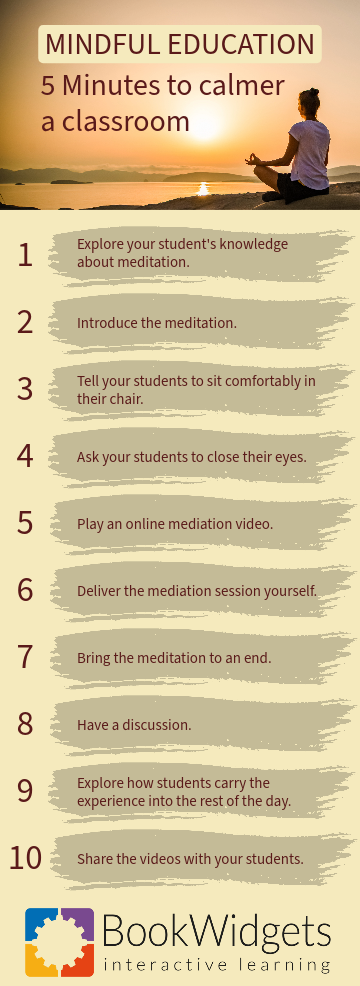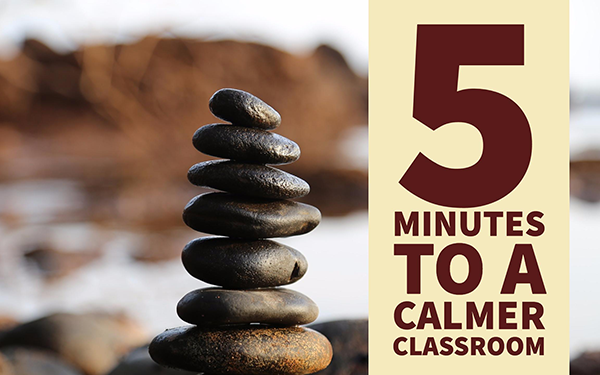Mindful Education: 5 Minutes to a Calmer Classroom
 Lucie Renard —
Lucie Renard —
When the sun is shining outside, and your students have to stay inside, they might have the urge to get really loud and excited because of the weather. They’re probably already making plans of what they are going to do when school’s out. But first, they have to endure 7 hours of you and other teacher colleagues.
That’s when the murmuring, talking, laughing and dreaming begins. So how do you get your students to concentrate? How do you create a calmer classroom?
It might seem funny, but mindfulness can help for focus and concentration. Of course, this would seem more appropriate to you in primary school. But actually, I don’t see the reason why. Middle school students are often too energetic as well.
In this blog post, I’ll show you what you can accomplish with meditation in your classroom and give you an exercise you can do with your students to calm them down. It will only take 5 minutes!
Mindfulness meditation in schools - statistics
Have you ever heard about mindfulness in school and that it has some great advantages? No? Then I’m the first one to drop it to you.
Meditation is becoming more and more trendy. Schools have also begun experimenting with the practice and are discovering that its techniques can help their students.

A school in New Haven, Connecticut, required yoga and meditation classes three times a week for its incoming freshman students. Studies found that after each class, students had significantly reduced levels of cortisol, a stress hormone, in their bodies.
Visitacion Valley Middle School specifically reduced suspensions by 45 percent during a meditation program in its first year. Attendance rates climbed to 98 percent, grade point averages improved, and the school recorded the highest happiness levels in San Francisco on the annual California Healthy Kids Survey.
Mindfulness education programs or programs that encourage meditation in schools do have other advantages. Yes, it reduces the stress level of a student, but it does so much more than that.
According to GreaterGood, meditation benefits are students’ self-control, attentiveness and respect for other classmates, enhances the school climate, and it even improves teachers’ moods.
Take a look at this interesting article that talks about the benefits of meditation in school.
Breathing meditation in your classroom
This exercise shows you how to deliver breathing meditation that students of any belief system can use.
Teaching mindfulness works best when students opt into the meditation session. It’s a good idea to describe the advantages of meditation to your students. Some students might find it silly. You could offer the mediation as a taster.

- Explore your student’s knowledge about meditation. Now, it’s also a good time to say that this meditation isn’t religious, but just a simple process of focusing on your breath. Maybe tease them with a fun fact: “Did you know that employees at Facebook and Google take part in meditation sessions at their workplace?”
- Introduce the meditation. Explain to your students what you are going to do for the next five minutes. They are going to sit quietly and practice their breathing. If you don’t like the term “meditation”, you can always just call it a breathing exercise.
- Tell your students to sit comfortably in their chair. It’s very important that they keep a straight back and have relaxed shoulders. You could watch this video about the meditation posture.
- Ask your students to close their eyes. Closing their eyes helps to prevent distraction and calm their mind.
- Play the online meditation video. Choose the length of the session depending on feedback and interest from students.
- You can also deliver the meditation session yourself after a bit of practice. Guiding a meditation session requires skill and experience.
- Bring the meditation to an end. Remind your students to become aware of their surroundings. The room around them, any sounds they can hear and their feet on the floor.
- Have a discussion. How did your students experience it? Was it what they expected? Would they like to do it again sometime? If so, would they like a longer or shorter meditation?
- Explore how students carry the experience into the rest of the day. Are they going to do it again if they are stressed, or distracted? Are they going to think about their breathing that moment?
- Share the videos with your students. Some students might be into meditation, so give them the opportunity to do it at home.
Wrap up
That wasn’t hard, was it? I hope you have the time to consider a meditation exercise like this for stress reduction and student well-being. You can find more meditation tips and exercises here.
For continued educational inspiration, be sure to follow us on Twitter and become part of our Teaching with BookWidgets Facebook group where you will discover more lessons ideas. To connect on a personal level, don’t hesitate to reach out to me (Lucie) on LinkedIn.



